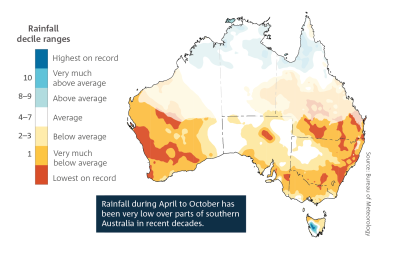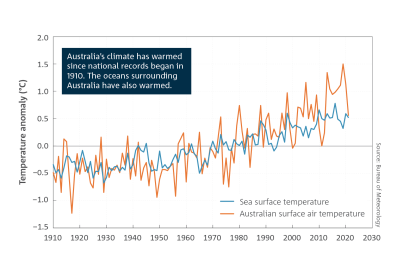Climate Change in Australia
Climate information, projections, tools and data
National Climate Statement:
Australia's Changing Climate
Australia is already experiencing the impacts of climate change, which vary across the country. Australia’s climate is projected to continue to change into the future.
The State of the Climate report is produced every two years by CSIRO and the Bureau of Meteorology. It provides an overview of the latest knowledge on how the climate is changing and how it will continue to change in the future. The report draws on a range of national and international sources, including the Sixth Assessment Report from the IPCC , national projections data and information provided through the Climate Change in Australia website and past observational data from the Australian Bureau of Meteorology .
The latest State of the Climate report (along with the previous reports) can be accessed at csiro.au and at bom.gov.au . The information presented here is based on the 2022 release of the State of the Climate report.
Australia is already experiencing the impacts of climate change:
- Australia’s climate has warmed by about 1.47 (± 0.24) °C since national records began in 1910, leading to an increase in the frequency of extreme heat events.
- This long term warming trend means that every decade since 1950 has been warmer than preceding decades.
- Australia’s warmest year on record was 2019, and the eight years from 2013 to 2020 all rank among the ten warmest years on record.

April to October rainfall deciles for the past 22 years (2000–21). A decile map shows where rainfall is above average, average, or below average for this period compared to all years from 1900 (when reliable rainfall records began). Areas across northern and central Australia that receive less than 40 per cent of their annual rainfall from April to October are faded. © Australian Government

Anomalies in annual mean sea surface temperature, and temperature over land, in the Australian region. Anomalies are the departures from the 1961–90 standard averaging period. Sea surface temperature values (data source: ERSST v5, www.esrl.noaa.gov/psd/) are provided for a region around Australia (4–46 °S and 94–174 °E). © Australian Government
- Despite the large natural year-to-year variability in Australian rainfall, underlying long-term trends are evident in some regions. For example:
- The southwest and southeast of Australia have experienced drier conditions, with more frequent years of below average rainfall, especially for the cool season months of April to October.
- Cool season rainfall has been above average in western Tasmania during recent decades.
- Northern Australia has been wetter across all seasons, but especially in the northwest during the northern wet season (October to April). However, rainfall variability remains high.
- There has been an increase in the intensity of heavy rainfall events in Australia. The intensity of short-duration (hourly) extreme rainfall events have increased by around 10 per cent or more in some regions over recent decades.
- There has been an increase in extreme fire weather and in the length of the fire season across large parts of Australia since the 1950s, especially in southern Australia.
- Sea surface temperatures around Australia have warmed by 1.05 °C since 1900, with eight of the 10 warmest years on record occurring since 2010.
- Warming of the ocean has contributed to longer and more frequent marine heatwaves.
- Global average sea level has risen by around 25 cm since 1880, half of this rise occurred since 1970.
- Rates of sea level rise vary across the Australian region, with the largest increases to the north and southeast of the Australian continent.
- A downward trend in maximum snow depth has been observed for Australian alpine regions since the late 1950s, with large year-to-year variability. Downward trends in the area covered by snow, length of time that cover persists and the number of snowfall days in Australia have also been observed.
- The observed long-term reduction in rainfall across many parts of southern Australia has led to reduced streamflow, although with considerable interannual variability.
- There has been a decrease in the number of tropical cyclones observed in the Australian region since 1982.
Australia’s climate is projected to continue to change over the coming decades. The following changes are projected:
- Australia is projected to continue to get hotter into the future, with more extremely hot days and fewer extremely cool days.
- The average temperature of each future year is now expected to be warmer than any year prior to the commencement of human-caused climate change. This is scientifically referred to as climate change 'emergence '.
- Ongoing climate variability means each year will not necessarily be hotter than the last, but the underlying probabilities are changing. This leads to less chance of cool years and a greater chance of repeatedly breaking Australia’s record annual average temperature (e.g. record set in 2005 was subsequently broken in 2013 and then again in 2019).
- While the previous decade was warmer than any other decade in the 20th century, it is likely to be the coolest decade for the 21st century.
- A longer fire season for the south and east and an increase in the number of days experiencing dangerous fire weather is projected.
- Australia's cool season rainfall is projected to decrease across many regions of the south and east, likely leading to more time spent in drought.
- As the climate warms, heavy rainfall is expected to become more intense throughout Australia.
- Average Australian sea levels are projected to continue to rise into the future, with regional differences.
- As the oceans continue to warm, more frequent, intense and long-lasting marine heatwaves are projected, leading to increased risk of more frequent and severe coral bleaching events.
- Fewer east coast lows are projected, particularly during the cooler months of the year. For events that do occur, sea level rise will increase the severity of some coastal impacts.
- Fewer tropical cyclones are projected, but a greater proportion of those that do occur are projected to be of high intensity, with ongoing large variations from year to year.
- In Alpine regions, an increase in snowmelt, especially at low latitudes, is projected along with a decline in snowfall.
- The amount of climate change expected in the next decade is similar under all plausible global emissions scenarios. However, by the mid-21st century, higher ongoing emissions of greenhouse gases will lead to greater warming and associated impacts, while lower emissions will lead to less warming and fewer impacts.
Further reading and resources:
- State of the Climate report
- Bureau of Meteorology: Climate change – trends and extremes
- National Environmental Science Program (NESP) Climate Systems Hub
- IPCC Sixth Assessment Report, The Physical Science Basis
Page last updated 13th December 2022



